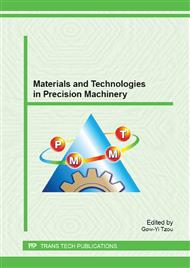
Based on materials, different punch radii (0.3, 0.35, 0.4, 0.45, and 0.5 mm), two sets of diameter-diameter ratio 1.(.167, 1.25, 1.33, 1.4167, and 1.5) and 2.(1.6, 1.45, 1.33, 1.231, and 1.143), and two sets of depth ratio 1.(1.3, 1.4, 1.5, 1.6, and 1.7) and 2.(2.14, 1.875, 1.67, 1.5, and 1.36) are used for the stamping processes to analyze the simulation and experimental difference in copper sheet-metal (C1100) miniature layered cups. Prandtl-Reuss flow rule is integrated with finite deformation theory and Updated Lagrangian Formulation (ULF) to establish the incremental elastic-plastic deformation Finite Element Method in Coulomb’s Friction Law for simulating the miniature layered cup process. Generalized rmin algorithm is utilized in the forming process for dealing with elastic-plastic behaviors and die contact. From the simulation data, the relationship among deformation history, punch load, and punch stroke, the stress-strain distribution, and the distribution of the thinnest thickness by different punch radii are acquired.
You might also be interested in these eBooks
Info:
© 2015 Trans Tech Publications Ltd. All Rights Reserved
[1]
M. Kawka, A. Makinouchi, Shell-Element Formulation in the Static Explicit FEM Code for the Simulation of Sheet Stamping, Journal of Materials Processing Technology 50 (1995) 105-115.
DOI: 10.1016/0924-0136(94)01373-9
Google Scholar
[2]
D.K. Leu, Finite-element simulation of the lateral compression of aluminium tube between rigid piates, International Journal of Mechanical Sciences 41 (1999) 621-638.
DOI: 10.1016/s0020-7403(98)00040-x
Google Scholar
[3]
H. Takuda, N. Hatta, Numerical analysis of formability of a commercially pure zirconium sheet in some sheet forming processes, Material Science Engineering 242 (1998) 15-21.
DOI: 10.1016/s0921-5093(97)00520-0
Google Scholar
[4]
Y.M. Huang, K.H. Chien, Influence of the punch profile the limitation of formability in the hole-flange process, Journal of Materials Processing Technology 113 (1999) 720-724.
DOI: 10.1016/s0924-0136(01)00597-0
Google Scholar
[5]
J.R. Cho, S.J. Moon, S.S. Kang, Finite Element Investigation on Spring-Back Characteristics in Sheet Metal U-Bending Process, Journal of Materials Processing Technology 141 (2003) 109-116.
DOI: 10.1016/s0924-0136(03)00163-8
Google Scholar
[6]
L.C. Sousa, C. f. Castro, C.A.C. Antonio, Optimal Design of V and U Bending Processes Using Genetic Algorithms, Journal of Materials Processing Technology 172 (2006) 35-41.
DOI: 10.1016/j.jmatprotec.2005.08.011
Google Scholar
[7]
R.M. McMeeking, J.R. Rice, Finite element formulations for problems of large elastic-plastic deformation, International Journal of Solids and Structures 11 (1975) 601-606.
DOI: 10.1016/0020-7683(75)90033-5
Google Scholar
[8]
L. Peng, F. Liu, J. Ni, X. Lai, Size effects in thin sheet metal forming and its elastic-plastic constitutive model, Material and Design 28 (2007) 1731-1736.
DOI: 10.1016/j.matdes.2006.02.011
Google Scholar


